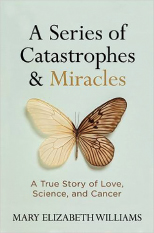
Bookmark
Title: A Series of Catastrophes & Miracles: A True Story of Love,
Science, and Cancer
Author: Mary Elizabeth Williams
Publisher: National Geographic Partners
Publication date: April 2016
Price: $26.00; hardcover, 304 pages
Readers of the recently published memoir A Series of Catastrophes & Miracles: A True Story of Love, Science, and Cancer find out that the book has a happy ending on the cover page of chapter 1. Spoiler: I lived, writes the author, Mary Elizabeth Williams, an acclaimed journalist with a list of impressive bylines to her name. It’s a curious lead, but it works, actually adding upfront context to the central drama of her story of survival.
The author opens the book in 2012, while attending a Gilda’s Club support group. She is battling stage IV melanoma, and, naturally, she knows her chances of long-term survival are slim. “I have a lot to talk about tonight. This morning, I had examined my shampoo bottle as I washed my hair and wondered if I would make it to the bottom,” writes Ms. Williams. These are the types of anxious thoughts patients with cancer share, and she delivers this kind of inner communication with delicacy and clarity.
‘No Evidence of Disease’
During her Gilda’s Club meeting, we learn that Ms. Williams is 3 months into a clinical trial. Nationally noted immunologist Jedd Wolchok, MD, Chief, Melanoma and Immunotherapeutics Service at Memorial Sloan Kettering Cancer Center, is managing her advanced cancer. She describes her side effects as “tolerable,” but she has no reason to complain since “the tumor on my back—the tender purple lump that rests right under my bra strap—has been looking smaller since my first treatment. Dr. Wolchok says it’s very encouraging.”
During the group session, she gets a call from Dr. Wolchok, telling her that the tumor on her back had completely receded, and the tumor in her lung was gone. “You present no evidence of disease,” Dr. Wolchok tells his now numb-with-joy patient. When she returns to the meeting, she sits next to a friend called Cassandra. “Hearing the news, Cassandra squeezes my hand. Tonight’s meeting will be the last time I see Cassandra. She will be dead in a month,” writes Ms. Williams. Tough stuff, and she captures it without sentimentality. Lesser writers have not had her restraint and would have overdramatized that poignant cancer crossroad.
Malignant Melanoma Diagnosis
In chapter 2, Ms. Williams turns back the clock to 2010, the year she received her cancer diagnosis. Ms. Williams noticed a scab on her head. She went to a dermatologist, who thought it looked like skin cancer, so she did a biopsy.
“I figured it was no big deal. I know lots of people who’ve had basal cell carcinomas removed. It’s the sort of thing people call the “good kind of cancer.” Until the phone rings: it’s Dr. Barry Silver, her dermatologist. “We got your biopsies back today, and I’m sorry to tell you this, but you have malignant melanoma…. I’ve made an appointment for you at Sloan Kettering tomorrow.”
Engaging Quality of Writing
To her credit as a writer, Ms. Williams engages the reader in the heartbreak and panic of hearing the word malignant. And with aplomb, she relays the news to her husband and kids and prepares for her visit to Sloan Kettering.
Imagine that someone woke you up in the middle of the night, put a pillowcase over your head, threw you in the trunk of a car, and then dumped you in a foreign country with the parting message, ‘This is where you live now.’ That is what the period immediately following finding out you have cancer is like.— Mary Elizabeth Williams
Tweet this quote
About her first day sitting in the waiting room, she writes, “Imagine that someone woke you up in the middle of the night, put a pillowcase over your head, threw you in the trunk of a car, and then dumped you in a foreign country with the parting message, ‘This is where you live now.’ That is what the period immediately following finding out you have cancer is like.”
That is a terrific analogy. Once again, it is the quality of the writing that separates this book from most cancer memoirs. Ms. Williams does an admirable job bringing the reader through her surgery and subsequent treatments, especially the immunotherapy trial she was on that saved her life. Moreover, the lay reader will come away highly informed about the cancer process from diagnosis and through the continuum of care. And the pages roll out effortlessly.
She tells a good story. She’s got a punchy, blogger-like rhythm that readers, especially the younger crowd, will enjoy. However, her book falls a bit short on clinical exposition, the doctor-patient working relationship, and management of the side effects of therapies to be suggested for The ASCO Post audience. ■

